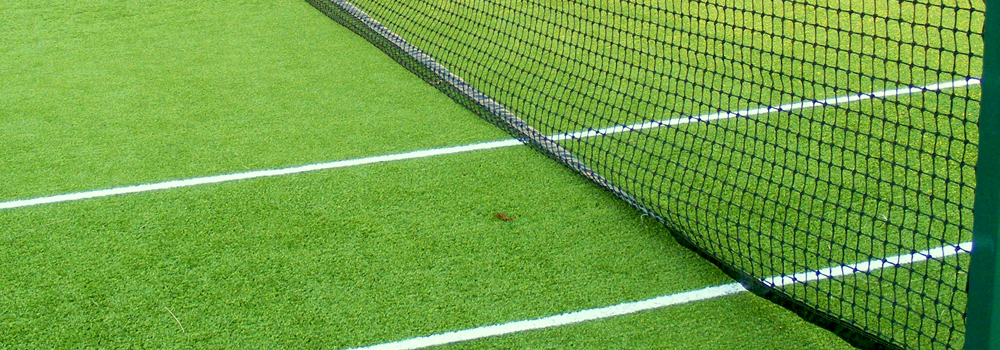Pre-season rolling should have begun, using your mower. Clay soils need a certain amount of moisture for effective rolling to be achieved with clay soils taking longer to warm up and, therefore, the grass will be slower to develop. If you are considering applying a worm suppressant, it may pay to wait until the soils have warmed up a bit more, ensuring you receive better results when applying the pesticide.
Spring renovations will be at the forefront of any planned maintenance regimes followed by some regular mowing activities to improve sward density.
Key Tasks for April

- Continue to roll the courts
- Fortnightly light scarification or verticutting
- Seed sparse or bare areas
Rolling. It is essential to carry out an effective rolling programme in April. Continue to roll the courts, firstly across the line of play, followed by rolling down the length of play. Timing of this operation is vitally important. Trying to roll when soil conditions are wet or too dry will not achieve the desired effect.
Mowing. The mowing height on the courts should be lowered to around 8-10mm for the playing season, but remember not to remove more than 1/3 of total grass height in each cut.
Light scarification or verticutting can be carried out at fortnightly intervals pre-season. Removing horizontally growing grasses and surface organic matter are always beneficial for the onset of court preparation which, together with brushing, will improve the quality of cut.




Spring represents the best time to undertake a broad spectrum chemical soil analysis. The subsequent report will help turf managers to make factual based decisions on further nutritional requirement throughout the year. Deficiencies can then be addressed through granular or foliar fertilisers, thus maximising plant health and surface quality.
The role of potassium is increasingly being understood with respect to water mobilisation, and recent research indicates an application of potassium in the spring helps to guard against drought stress in the summer.
Since the enforcement of the clean air act, we see that sulphur levels are often low in many soils. Sulphur is a vital element for plant health, playing a key role in protein production which drives immune response in many organisms. Proteins are created from amino acids, many of which are sulphur based. Ensuring adequate sulphur levels in the spring, with an application of a granular fertiliser containing ammonium sulphate, will help to boost levels as the season starts.
Be sure to check and compare the nutritional analysis lists on all your fertilisers; looking at values other than NPK will reveal additional nutrients in the mix which may be of benefit - Fertilisers
Biostimulants
Increasingly the role of biostimulants is being recognised by turf managers at all levels:
- Carbon sources: for example BioMass sugar facilitates a balancing of the carbon to nitrogen ratio in the soil. This allows both microorganisms and plants to maintain this vital ratio within their systems when up-taking the nutrient, better facilitating nitrogen efficiency and utilisation. Simply put, sugars are essentially soil life and plant carbon fertilisers, which can be applied regularly to rootzones throughout the year.
- Seaweed: when applied as a liquid foliar treatment, contains a variety of plant hormones, enzymes, vitamins and trace elements which should be utilised to prime plant defences by eliciting better responses to stress events and provides a general stimulator of plant metabolic function. Liquid seaweed also acts as a chelating agent for nutrients. Seaweeds should be used on a regular basis to prime plant defences and stimulate efficient plant function.
- Humates: are naturally occurring core components of healthy soils, produced as a by-product of organic decomposition. Humate substances act as a soil structure improver, microorganism habitat, microorganism stimulant, nutrient bank improver, nutrient carrier, chelator. Humates can be applied throughout the year to increase nutrient uptake and efficiency, boost soil biology function and habitat, and increase the nutrient holding capacity of the soil.
Wetting Agents
Often wetting agents are applied too late in the season to be made the best use of. Quite often, the use of wetting agents will be approached in a similar vein to disease management i.e. waiting for symptoms before treating the problem. Once dry patch areas are visible, the chemistry within the soil necessitates the need for a curative wetting agent to strip away the organic proteins causing the water repellence; these wetting agents can be quite harsh to soil ecology and, as a result, there are not too many on the market.
The majority of wetting agents contain two molecules which act independently from each other for different effects:
Penetrant molecule: a penetrant wetting agent is designed to move water away from the surface and down through the profile.
Polymer molecule: a polymer molecule is designed to capture water and hold it lower down in the profile.
The majority of wetting agents will utilise both molecules, the penetrant to firstly move water away from the surface where it may contribute towards surface wear or just simply evaporate; the polymer molecule to then capture that water further down the profile and retain it for plants to uptake.
This strategy requires a build-up of the molecules and subsequent water cycling processes ahead of dry periods to help PREVENT the onset of dry conditions. As a result, to gain the best effect from wetting agents, they should be applied monthly through the growing season starting in the spring.

Keep an eye on fungal disease attack and use approved fungicides to treat infected areas. The typical types of diseases you may come across are:
- Fusarium Patch
- Red Thread
- Fairy Rings
- Anthracnose
Some of the damage symptoms that insects and pests can cause are very similar to those caused by diseases, so it is very important to correctly diagnose the problem before treatment is applied.
More information on these and many others can be found here: https://www.pitchcare.com/useful/diseases.php
The normal cultural control for disease prevention should be adopted, such as monitoring weather conditions for peak periods, removing morning dews and avoiding excessive applications of nitrogen. Increasingly, turf managers will find that many of the weapons in the fungicidal armoury are likely to become less available in the years to come, particularly in respect to curative contact type active ingredients.
Under this climate, it will be critically important that turf managers at all levels are equipped with the knowledge and understanding to maximise the use of systemic fungicides for best effect. This integrated approach will go hand in hand with reference to historical occurrence records and disease forecasting technologies, prior to visible signs of infection, and will be the only method of chemical control. Increasingly, turf managers will have to manage disease outbreaks preventatively, by using cultural controls and maintaining plant health and eliciting plant resistance through careful nutritional applications. The key elements in this instance being calcium, phosphite and iron.
The wisest of individuals will take early opportunities to seek out and engage with organisations and associations, when learning and professional development opportunities present themselves.
More advice and information is available on the website – Fungicide Programmes
Worms can also be very active at this time of the year so treatments can be carried out, if needed; the use of Carbendazim is the only active ingredient for controlling worms, for the time being. All personnel should be suitably qualified in the application of chemicals - Carbendazim withdrawal timescale
Moles can be attracted to areas where worms are prevalent; these need to be treated as they can cause a lot of damage to outfields and other surrounds.
Pests
Many areas are suffering the effects of chemical insecticide withdrawal over the past year, with chafer grubs and leatherjackets causing problems for turf managers, either through their direct action on the grass plant or through the indirect damage of mammals and birds seeking out a meal.
There are no effective treatments for the control of these insect pests in the spring control should be carried out at the correct time of the year with entomopathogenic nematodes. Nematode treatments are very successful when applied within the correct application windows which respect the life cycles of both pest and control.
More information and advice is available on the website – Chafers and Leatherjackets.
You, should have had your mower serviced and sharpened ready for the new season.
- Inspect machinery and equipment
- Clean after use
- Remember to check air filters
- Inspect and reset mowing blades on cylinder mowers to ensure they remain sharp

Some of the courses available are:
- Chainsaws - CS30 and CS31
- H&S Refresher Training on Combined Turf Care Equipment; Tractors and Trailers; All Mowers (Ride-on and Pedestrian)
- Machinery Courses on ATVs; Tractors: Brushcutters/Strimmers; Mowers (ride-on and Pedestrian)
- Pesticide Application (PA courses)
- Stem Injection of Invasive Species (Japanese Knotweed etc.)
- Basic Trees Survey and Inspection
More details about all the courses can be found on our new Grounds Training website, or you can email Chris Johnson for information.
- Ensure drainage outfalls, channels and ditches are clear
- Inspect stored posts, nets, seating and notice/score boards
- Inspect and remove debris from playing surface
- Regular sweeping and brushing
- Repair any hollows or damaged areas
- Repaint lines


